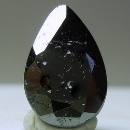|
|
||||||||||||||||
|
||||||||||||||||
|
||||||
|
|
|
|
Strüverite
(variety
of Rutile) |
|
| | |
| Discovered in 1907. IMA status: Not Valid; a variety of Rutile (Discredited by IMA 2006) | ||
|
| ||
|
Chemistry |
|
|
| |
|
(Ti,Ta,Fe2+)O2 | |
|
|
Titanium Tantalum Iron Oxide |
|
Molecular Weight: |
117.38 gm |
|
Composition: |
Tantalum |
30.83 % |
Ta |
37.65 % |
Ta2O5 |
|
|
Titanium |
24.48 % |
Ti |
40.83 % |
TiO2 |
|
|
Niobium |
7.92 % |
Nb |
11.32 % |
Nb2O5 |
|
|
Iron |
9.52 % |
Fe |
12.24 % |
FeO |
|
|
Oxygen |
27.26 % |
O |
|
|
|
|
|
100.00 % |
|
102.04 % |
= TOTAL OXIDE |
|
|
|
||||
|
Classification |
|
|
| |
|
Oxides | |
|
Dana 8th Edition ID: |
4.4.1.3 |
|
|
4 : SIMPLE OXIDES
|
|
Related to: |
Rutile Group. Forms a series with Ilmenorutile; Ta:Nb > 1. |
|
Members of Group: |
Rutile Group: Argutite, Cassiterite, Paratellurite, Plattnerite, Pyrolusite, Stishovite, Tripuhyite |
|
Varieties: |
None |
|
Synonyms: |
Strüverite (of Zambonini) |
|
|
|
|
Crystal Data |
|
|
|
|
|
As Dipyramidal, prismatic crystals, to several cm, with striated prism faces. |
|
|
Common on {101} |
|
|
|
|
|
Physical Properties |
|
|
|
|
|
Distinct on {110} |
|
|
Conchoidal |
|
|
Brittle |
|
|
6.0 - 6.5; VHN = 911 - 998 |
|
|
4.20 - 5.80 (g/cm3) |
|
|
None |
|
|
Not Radioactive |
|
|
|
|
|
Optical Properties |
|
|
|
|
|
Black; red or reddish brown in transmitted light; light gray in reflected light |
|
|
Opaque; translucent through thin edges |
|
|
Adamantine, Resinous |
|
|
Bereflectance: |
Weak; R1 - R2: n.d. |
|
Strong |
|
|
Strong; E = brown; O = dark bluish green or greenish blue |
|
|
Strong |
|
|
|
|
|
Occurances |
|
|
|
|
|
Geological Setting: |
A late primary mineral in granite pegmatites; rarely detrital. |
|
Common Associations: |
Columbite, Ilmenite, Beryl, Cassiterite, Zircon, Monazite, Albite, Microcline |
|
Common Impurities: |
Fe, Ta, Nb, Cr, V, Sn |
|
Type Locality: |
Craveggia, Val Vigezzo, Peidmont, Italy |
|
Year Discovered: |
1907 |
|
View mineral photos: | |
|
|
|
|
More Information |
|
|
|
|
|
| |
|
|
|
|
Locations:
from Craveggia, Val Vigezzo, Piedmont, Italy. At Vêñá, near Rozná, and
Písek, Czech Republic. In the Etta mine, near Keystone, Pennington County, South Dakota, USA.
At Tongafeno, Fefana, Mananjary, Ampangabé, and elsewhere in Madagascar. From near Salak
North, Kuala Kangsar, Perak, Malaya. At Globe Hill, Western Australia. Other localities are
reported, either undefined, or the material requiring modern confirmation.
|
|
|
We
have not photographed our Strüverite gems yet. Please
check back soon. |
